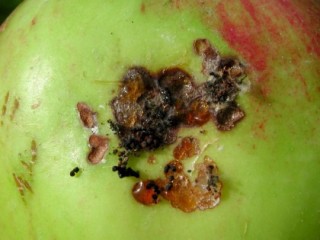
Larvae feed on the flesh of apple fruits around the stalks or where fruits are touching or where fruits are in contact with leaves or branches.
- They tie leaves and plant material together with silken webbing to make a shelter often attached to the surface of a fruit or branch.
- Large areas of skin and flesh are removed, wounds tend to weep and becoming covered by a sticky mass of black frass.
- They are usually surface feeders but sometimes penetrate more deeply into the flesh.
- Crop losses can be very high, approaching 100%.
- Larvae also feed on the bark of branches and the wounds may become infected with canker.
Other pests with which Blastobasis may be confused
Larvae of several leaf-rolling tortrix moths cause similar, though less severe damage, including larvae of the summer fruit tortrix moth, Adoxophyes orana.
- The damage caused by Blastobasis tends to be more severe and wounds tend to weep and become contaminated with black frass and there are deeper excavations into the flesh.
